Amateur Astro-imagers Get Ready for Juno
Planetary scientists are counting on amateur observations to enhance the results from NASA's forthcoming Juno mission.
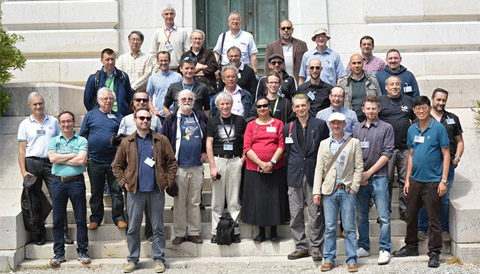
Attendees at the Juno pro-am workshop pose for a group picture at Côte d'Azur Observatory in Nice, France. Click here for a version that identifies the participants.
Christopher Go
Christopher Go
When it comes to solar-system studies, planetary scientists have long valued the contributions made by amateur observers.
So it's hardly surprising that, on May 12–13, amateurs and professionals interested in supporting NASA's Juno mission met in Nice, France, for a workshop dedicated to projects and techniques related to Jupiter observations.
The Juno spacecraft, launched by NASA in August 2011, is set to arrive at the giant planet on July 4th and go into orbit around it. The spacecraft's key objectives are weighted toward internal structure, atmospheric composition, and magnetospheric surveys.
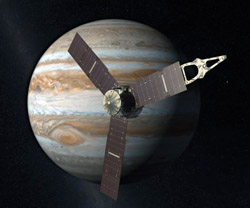
Launched from Earth in 2011, NASA's Juno spacecraft will arrive at Jupiter in July 2016 to study the giant planet from an elliptical, polar orbit.
NASA / JPL
NASA / JPL
Although Juno will image the planet at very high resolution, especially in the polar regions, it lacks the ability to create global portraits. So it falls to Earth-based observations to watch of regions out of view from the probe, and to acquire the large-scale views to provide context for the spacecraft's small-scale scrutiny.
Amateur images will be important not only before Juno's arrival but also during the planned 20 months of high-resolution imagery. Features and activity in the Jovian atmosphere must be identified and followed long before the beginning of the Juno mission's high-resolution phase.
Fortunately, amateur observers have maintained regular, near-continuous scrutiny of Jupiter for many years, and this long-term monitoring will help scientists to adjust the mission goals.
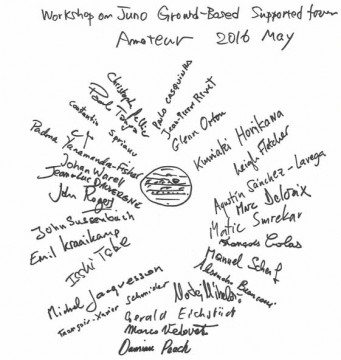
May 2016's Juno workshop brought together amateur and professional planetary imagers from around the world.
Glenn Orton
Glenn Orton
The workshop's 30 attendees shared a great deal in their two days together. Information about what has been said during the meeting will be shared to other interested amateurs. The various talks, recorded on video, are now accessible to anyone interested in this rewarding observing activity.
Highest on the "to-do" list for the months ahead is to help maintain the ground-based survey of Jupiter, so lots of discussion focused on the necessary equipment, imaging, and processing tools and techniques needed for that task. For example, more and more planetary imagers are utilizing infrared and methane-band filters, as well as atmospheric-dispersion correctors.
Software Makes Advances Possible
A consensus is emerging toward the use of three specific software packages to get good data. Autostakkert!2 is universally praised for its simplicity and accurate performance in aligning and stacking raw frames. Registax 6 is recognized for the quality of its wavelets interface (wavelets are a way to represent and analyze images with different spatial resolutions). WinJupos has won its place in this trio because as it has functions to correct the rotation of fast-spinning planets like Jupiter, thus increasing the total time of imaging sessions far beyond theoretical limits.
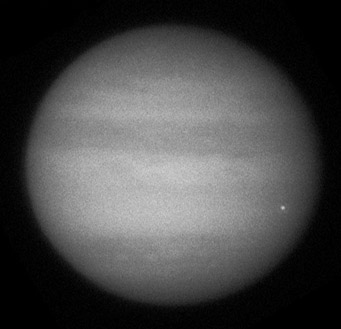
The bright, 2-second flareup appears near Jupiter's right (celestial east) limb in this frame from a video that Anthony Wesley was recording at 20:31:29 UT on June 3, 2010. South is up.
Software improvement could play a major role in detecting Jovian fireballs. All recent events from 2009 to 2016 were detected only thanks to the amateurs' vigilance. But statistically we're missing most of them because they are short-lived and not very bright. So ideally we'd utilize some kind of software to scan all recorded videos to be sure that nothing has been missed by the observer's eye. Some imagers already use DeTeCt software for this purpose. It's important to increase the number of videos analyzed to improve statistics of detection — negative results being very important as well — to evaluate more accurately how often such impacts take place.
Cooperation between amateur and professionals will be supported by maintaining or improving some specific projects and websites. The JunoCam homepage, for example, is built to collect amateur images in a special format for science use during the Juno mission. Observers can send raw images so scientists can look at them without linear distortion; a special format can be chosen within WinJupos to send the data with complete information about time and longitudes imaged. On this website, people will be able to vote for features of interest they see on Jupiter that will then be observed by Juno.
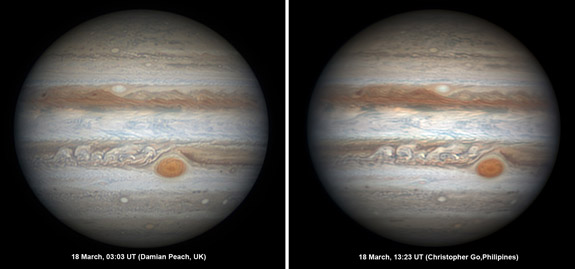
Images of Jupiter taken just 10 hours (one rotation) apart demonstrate the capabilities of modern amateur astrophotography and how it will benefit NASA's Juno mission.
Damien Peach / Christopher Go
Damien Peach / Christopher Go
The JunoCam homepage is not the only website that will help observers and scientists to work together: a new version of the Planetary Virtual Observatory and Laboratory (PVOL) website will be set up in coming months to facilitate the analysis of interesting images — for example to calculate zonal wind speeds on Jupiter).

JPL planetary scientist Glenn Orton has long championed the value of amateur astronomers' planetary observations. Here, during May's pro-am workshop in France, he monitors an ongoing Jupiter observing session with NASA's Infrared Telescope Facility in Hawai'i.
Glenn Orton
Glenn Orton
A word should be said about the current Jovian activity. Basing his analyses on the JUPOS project, involving measurements of positions and drifts of various Jupiter features, John Rogers (British Astronomical Association) urged observers to watch for a possible revival of the planet's North Temperate Belt (NTB). This would start with a very bright spot in this region observable from Earth, and then the spacecraft could follow up to record more details.
Finally, amateur images will provide used in long-term project of mapping and animating the clouds of Jupiter will be fed by amateur images. The JUPOS team (Marco Vedovato) is working on this as well as the "Voyager 3" project (talk by Johan Warrell).
As you can see, interested amateurs have many opportunities to participate in this exciting pro-am project during the Juno mission!
No comments:
Post a Comment